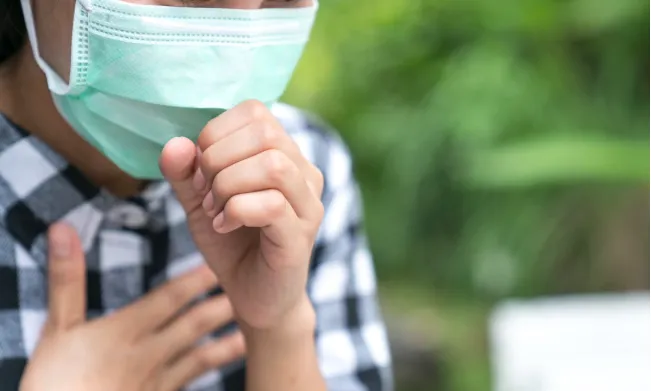Coughing is a common manifestation of respiratory system diseases, with various conditions such as colds and bronchitis triggering cough symptoms. In Traditional Chinese Medicine (TCM) theory, cough can be classified into several syndromes, such as phlegm-damp cough and phlegm-heat cough. Although they differ by only one character, there are significant differences in etiology, symptoms, treatment methods, and medication choices. Let’s explore these distinctions in detail.

1. Phlegm-Damp Cough
Overview: Phlegm-damp cough is a type of internal injury cough, primarily caused by spleen and stomach dysfunction. When the spleen is injured, it fails to transport fluids properly, leading to the accumulation of dampness and phlegm, which obstructs the lungs and hinders their ability to disperse and descend, resulting in cough and phlegm production. This condition is commonly seen in chronic bronchitis and similar diseases.
Characteristics: Often accompanied by symptoms of spleen dysfunction.
Main manifestations: Persistent or recurrent cough, with copious phlegm that is white or grayish in color, thick and sticky in texture, difficult to expel. Coughing may worsen in the morning or after consuming rich or cold foods. The cough is relieved when phlegm is expelled. Accompanying symptoms may include chest tightness, abdominal fullness, nausea, poor appetite, and loose stools. The tongue coating is white and greasy, and the pulse is slippery.
Treatment principles: Strengthen the spleen, dry dampness, stop cough, and resolve phlegm.
Medication choices: Er Chen Wan (Two Aged Pills), Liujunzi Wan (Six Gentlemen Pills), etc.
✎ Medication analysis (Er Chen Wan): Er Chen Wan consists of Chen Pi (Aged Tangerine Peel), Zhi Ban Xia (Processed Pinellia), Fu Ling (Poria), and Gan Cao (Licorice). The chief herb, Zhi Ban Xia, dries dampness and resolves phlegm while harmonizing the stomach and descending rebellious qi. Chen Pi regulates qi and strengthens the spleen, enhancing the action of the chief herb. Fu Ling promotes urination and drains dampness, assisting in phlegm resolution and strengthening the spleen to prevent phlegm generation. Gan Cao harmonizes the other herbs and strengthens the spleen. Together, these four herbs work to dry dampness, resolve phlegm, and regulate qi, used for treating cough with copious phlegm due to phlegm-damp stagnation, along with symptoms of chest fullness, nausea, and vomiting.
2. Phlegm-Heat Cough
Overview: Phlegm-heat cough is also a type of internal injury cough, primarily caused by external pathogens and internal organ injuries leading to phlegm-heat accumulation in the lungs. This condition hinders the lungs’ ability to disperse and descend, causing cough. It is commonly seen in infectious lung diseases.
Characteristics: Often accompanied by signs of yang heat.
Main manifestations: Frequent and severe cough, with coarse breathing or a rattling sound in the throat, copious phlegm that is thick and yellow, difficult to expel, possibly with a fishy or hot taste, or even blood-streaked phlegm. Accompanying symptoms may include fever, flushed face, chest and rib fullness, dry mouth and throat, and a desire to drink. The tongue is red with a thin yellow or greasy coating, and the pulse is slippery and rapid.
Treatment principles: Clear heat, purge the lungs, resolve phlegm, and stop cough.
Medication choices: Juhong Wan (Tangerine Peel Pills), Compound Xianzhuli Liquid, San She Dan Chuan Bei Tang (Three Snake Gallbladder and Fritillaria Syrup), etc.
✎ Medication analysis (Compound Xianzhuli Liquid): This formula consists of Xianzhuli (Fresh Bamboo Juice), Yuxingcao (Houttuynia), Sheng Ban Xia (Raw Pinellia), Sheng Jiang (Fresh Ginger), Pi Pa Ye (Loquat Leaf), Jie Geng (Platycodon), and Bo He You (Peppermint Oil). The chief herb, Xianzhuli, is sweet and bitter, cold in nature, and has the function of clearing heat and resolving phlegm. Yuxingcao clears heat and detoxifies, while Sheng Ban Xia, Pi Pa Ye, and Jie Geng dry dampness, resolve phlegm, and moisten the lungs to stop cough, serving as assistant herbs. Sheng Jiang harmonizes the stomach and resolves phlegm, while Bo He You disperses heat and alleviates throat discomfort, acting as a messenger herb. Together, these herbs clear heat, resolve phlegm, and stop cough, used for phlegm-heat cough.
Summary of Differences Between Phlegm-Damp Cough and Phlegm-Heat Cough
| Phlegm-Damp Cough | Phlegm-Heat Cough | |
| Key syndrome | Phlegm and dampness | Phlegm and heat |
| Treatment core | Clear heat | Dry dampness, strengthen the spleen |
| Phlegm color and texture | White or grayish, thick | Yellow, thick, possibly blood-streaked |
| Phlegm taste | Sweet taste | Fishy or hot taste |
| Accompanying symptoms | Chest tightness, abdominal fullness, nausea, poor appetite, loose stools | Fever, flushed face, dry mouth and throat, sore throat |
| Representative medication | Er Chen Wan | Compound Xianzhuli Liquid |
Combined Medication for Phlegm-Damp Cough and Phlegm-Heat Cough
In treating phlegm-damp cough and phlegm-heat cough, in addition to selecting appropriate TCM medications based on syndrome differentiation, it is also advisable to combine with expectorants such as Ambroxol Hydrochloride, Carbocisteine, and N-acetylcysteine to significantly improve the condition of thick phlegm that is difficult to expel. Specific combinations are as follows:
-
Phlegm-Damp Cough: Er Chen Wan + Ambroxol Hydrochloride Oral Solution + Jianpi Wan (Spleen Strengthening Pills)
(The purpose of combining with Jianpi Wan is to improve spleen and stomach function and enhance the ability to transport water and dampness.)
-
Phlegm-Heat Cough: Compound Xianzhuli Liquid + Lian Zhi Xiao Yan Pian + Carbocisteine Oral Solution
(If an infection is confirmed, antibiotics should be combined for treatment.)
The above is a brief introduction to phlegm-damp and phlegm-heat cough. In the differentiation of cough syndromes, in addition to the two types discussed in this article, common cough syndromes also include wind-heat cough, wind-cold cough, wind-dry cough, yin deficiency cough, and liver fire invading the lungs cough. Each of these syndromes has many differences, and therefore accurate differentiation followed by appropriate medication treatment is essential for achieving the best therapeutic effect.

